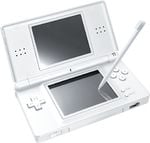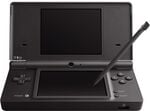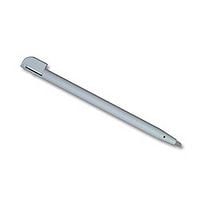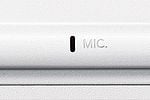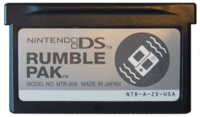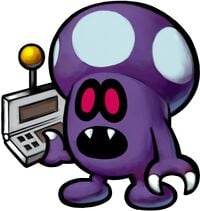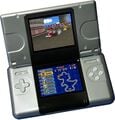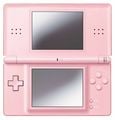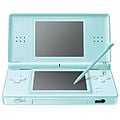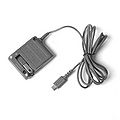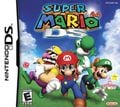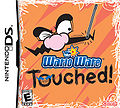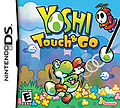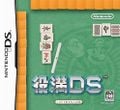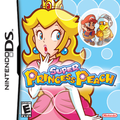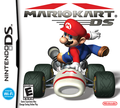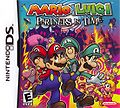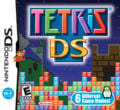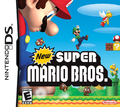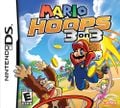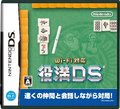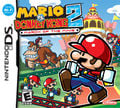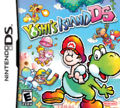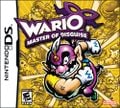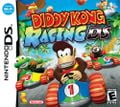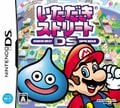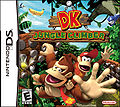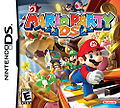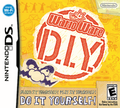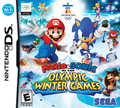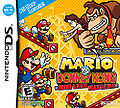Nintendo DS
- This article is about the handheld video game system. For the battle course in Mario Kart DS, see Nintendo DS (battle course).
- "DS" redirects here. For other uses of "DS", see DS (disambiguation).
- Not to be confused with Nintendo 3DS.
| Nintendo DS | |
|---|---|
Official logo 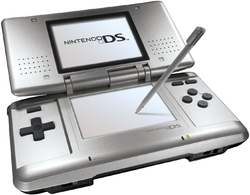 The first commercial model of the Nintendo DS | |
| Generation | Seventh generation |
| Release dates | Nintendo DS: Nintendo DS Lite: |
| Discontinued | Nintendo DS: 2009[citation needed] Nintendo DS Lite: April 22, 2011[12] |
| Predecessor | Game Boy Advance |
| Successor | Nintendo 3DS |
- “Touching is good.”
- —United States advertisement slogan for the Nintendo DS
- “Pick up and play.”
- —European advertisement slogan for the Nintendo DS
The Nintendo DS, or simply the DS, is a foldable handheld game system released by Nintendo in 2004. The Nintendo DS is Nintendo's sixth handheld system, being the successor to the Game Boy Advance. It features two three-inch screens. "DS" stands for "Dual Screen" (though, at its conception, it was intended to stand for "Developers' System").[13] The system introduces many new features to the Nintendo handheld lineup, including a resistive touchscreen, visible operating system GUI (in the form of the main menu), stereo sound output via both the built-in speakers and 3.5mm headphone jack (a first for Nintendo handhelds, which previously sported a single mono speaker despite supporting stereo through the headphone jack), audio input via a pinhole microphone, and wireless connection capabilities. It is also the first Nintendo handheld to natively support 3D polygonal graphics as opposed to only sprites, making it similar to the Nintendo 64 in terms of graphical capacity. The DS also introduces a feature known as sleep mode, where one can close the console and preserve its battery life, and in Super Mario 64 DS and New Super Mario Bros., closing the system is accompanied by Mario saying, "Buh-bye!" The DS (and by extension the DS Lite) provides backwards compatibility for Game Boy Advance games (though this does not work with the Nintendo DSi models), although only limited to single-player experiences as the Game Link Cable and Wireless Adapter support are missing. Similar to the Game Boy Micro, the DS and DS Lite cannot play games made for the Game Boy and Game Boy Color. In early 2011, the Nintendo DS received a successor, the Nintendo 3DS.
The DS is the first Nintendo system to include wireless functions, allowing it to link up with other DS's without any wires or add-ons. This was also the first system Nintendo made to go online, via Nintendo Wi-Fi Connection, of which Mario Kart DS was the first to utilize. Since May 20, 2014, online play for many Nintendo DS games has been discontinued due to the closing of the Nintendo Wi-Fi Connection service.[14] Conversely, the DS is Nintendo's last system to be distributed in South Korea through a third party licensor, specifically Daewon Media (who also handled the South Korean releases of the Game Boy Advance and Nintendo GameCube).[15] Starting with the Wii, Nintendo's products would be released in the region through the newly established Nintendo of Korea.
The Nintendo DS retains the ,
![]() ,
, ![]() ,
, ![]() ,
, ![]() ,
, , and
buttons from the Game Boy Advance and also includes the
![]() and
and ![]() buttons, so it has all of the same buttons as a Super Nintendo Entertainment System controller.
buttons, so it has all of the same buttons as a Super Nintendo Entertainment System controller.
Models[edit]
Nintendo DS Lite[edit]
- NintendoWiki article: Nintendo DS Lite
A newer model named the Nintendo DS Lite was released in 2006 and contains all the features of the original Nintendo DS with some new features such as a significantly brighter screen (with four adjustment options), a lighter weight, and a smaller overall size (having the negative side effect of a regular Game Boy Advance cartridge protruding out from the bottom, similar to playing a Game Boy or Game Boy Color cartridge in the Game Boy Advance). The Nintendo DS Lite sold 89.19 million units as of 2010.[citation needed] It was also the final handheld system to have backwards compatibility with Game Boy Advance games.
Nintendo DSi and DSi XL[edit]
- Main article: Nintendo DSi
A third model, called the Nintendo DSi, was first released in Japan in December 2008. It is thinner, lighter, and brighter than the Nintendo DS Lite, having removed the Game Boy Advance slot. However, this means that the Nintendo DS Rumble Pak, which was used with titles such as Mario & Luigi: Partners in Time, alongside other peripherals which used the slot, cannot be used. Two cameras, music playback functions, Wi-Fi, internet browser, larger screens, and a Wii-like channel interface were added. Additionally, the console supports WPA encrypted networks.
The DSi is also able to download games from the Nintendo DSi Shop, which are then stored on an SD Card or in internal memory. It was released in Japan on November 1, 2008, in Australia on April 2, 2009, in Europe on April 3, 2009, and in North America on April 5, 2009. The DSi's front has a camera lens, and another, smaller lens is located where the mic was positioned on the Lite, allowing for photos to be taken with the DSi. In 2009, Nintendo later released the Nintendo DSi XL, with the "XL" standing for "Extra Large". It is also the heaviest of the four models.[16]
Stylus[edit]
The stylus is a pencil-like accessory that comes included with the Nintendo DS system. The instrument is often used in conjunction with the Touch Screen. Usually, the stylus is used to make menu selections, which the player can do by bringing the stylus in contact with their selection on the Touch Screen. Additionally, the stylus is often useful for touching precise points on the Touch Screen during gameplay. For example, New Super Mario Bros., Super Mario 64 DS, and Wario: Master of Disguise use the stylus for minigames such as Wanted! and Roach Smash. The stylus is also used to control Minis in Mario vs. Donkey Kong 2: March of the Minis and Mario vs. Donkey Kong: Mini-Land Mayhem!.
On the DS, the stylus slot is located on the back, and is inserted downwards, relatively to the DS itself. On the DS Lite and DSi, however, it was relocated to the right side of the system, and is inserted from right to left, relative to the DS Lite or DSi.
The stylus for the DS is noticeably thinner than the stylus for the DS Lite. A DS generally comes with two styluses when purchased, with extra styluses available for purchase separately. Special styluses were also released, some as promotions for certain games, such as touch pens based on New Super Mario Bros. depicting Mario and Luigi.
See also[edit]
Microphone[edit]
The ![]() microphone is a feature on the Nintendo DS. On the original DS, it is at the lower left-hand corner, right below the screen. On the DS Lite, it is at the middle in between the two screens. Its function is to accept audio input. Blowing into it will allow events to happen in the game that the player is playing, including:
microphone is a feature on the Nintendo DS. On the original DS, it is at the lower left-hand corner, right below the screen. On the DS Lite, it is at the middle in between the two screens. Its function is to accept audio input. Blowing into it will allow events to happen in the game that the player is playing, including:
- Mario Kart DS: Balloon Battle has the drivers' reserve balloons put into use by blowing into the microphone. The
 button can also be used, but is slightly slower compared to a full breath.
button can also be used, but is slightly slower compared to a full breath. - Super Princess Peach: In the minigame Toad Jump, blowing into the microphone is needed to make Toad jump over obstacles.
- Mario Party DS: Some minigames specifically use the microphone, such as Big Blowout.
- WarioWare: Touched!: Mike's Mic Rocking level revolve around the microphone.
- WarioWare: Snapped!: One microgame on the Jimmy Coaster requires using the microphone, to blow off a man's scarf.
- Wario: Master of Disguise: Wicked Wario requires blowing into the microphone to make him fly.
In other games, the player must say words into the microphone. In Mario & Sonic at the Olympic Games, the player must clap into the mic to gain inspiration from the crowd in Long Jump and Triple Jump. Also, in the game Mario & Luigi: Bowser's Inside Story, the player needs to use the microphone at certain points, such as breathing out fire as Giant Bowser.
Rumble Pak[edit]
- NintendoWiki article: Rumble (feature) § Nintendo DS
This accessory is shaped like a Game Boy Advance Game Pak, which it inserts into the GBA slot of the Nintendo DS or Nintendo DS Lite. It is incompatible with the Nintendo DSi, Nintendo DSi XL, or any Nintendo 3DS because they lack the required GBA slot. Super Mario games that support the Rumble Pak are Mario & Luigi: Partners in Time, Diddy Kong Racing DS, Super Princess Peach, and Wario: Master of Disguise.
Appearances in the Super Mario franchise[edit]
WarioWare series[edit]
The plot of WarioWare: Touched! revolves around Wario obtaining a gaming console resembling a Nintendo DS and using it to market new microgames.
A Nintendo DS appears in some of the microgames. In WarioWare: Touched!, it can be seen in the Pushing Buttons microgame. In WarioWare: Smooth Moves, a Nintendo DS appears in the microgames Brain Age, and Wario Hunting as one of the possible baits. In WarioWare: Get It Together!, a Nintendo DS appears in the second level difficulty of the WarioWare microgame.
In WarioWare: Smooth Moves, a Nintendo DS also appears as a sound effect icon in the Sound Studio.
A Nintendo DS is one of the unlockable souvenirs in WarioWare Gold.
Mario Kart DS[edit]
One of the battle courses in Mario Kart DS is the Nintendo DS. It is a nod to the Nintendo GameCube battle course from Mario Kart: Double Dash!!, as it is based on the GameCube. A picture of the original DS can be seen on some of the billboards in Mario Circuit.
Mario & Luigi series[edit]
Mario & Luigi: Partners in Time[edit]
In Mario & Luigi: Partners in Time, Shroobs call saucers by using a silver, flip-top communicator. Because the Nintendo DS has the capability to send verbal messages to friends, this may be a reference to the Nintendo DS. Additionally, Professor E. Gadd is shown to own a Nintendo DS with an apparent time radar he used to locate Princess Peach at the beginning of the game; he later uses the DS to operate the Hydrogush 4000.
Mario & Luigi: Bowser's Inside Story[edit]
In Mario & Luigi: Bowser's Inside Story, the Emoglobins that run the Gauntlet and Cholesteroad are shaped similarly to the DS systems. Additionally, Dark Fawful uses a device that resembles a Nintendo DS to track down the Dark Star.
Super Paper Mario[edit]
Super Paper Mario includes a computer console called the Dining Specializer, which is modeled after the Nintendo DS Lite (and can also be abbreviated "DS"). There is also a two-screened handheld that resembles a Nintendo DS known as a Training Machine, which the fortune teller Merluvlee wanted to use to train her brain (which, in turn, is a reference to the popular DS title, Brain Age, known in British English as "Brain Training").
Mario Strikers Charged[edit]
In Mario Strikers Charged, Strikers' Times are shown on the Touch Screen of a Nintendo DS Lite.
Mario Party DS[edit]
In Mario Party DS, when the player defeats Bowser at the end of the story mode, the five Sky Crystals join and form something like a crystal Nintendo DS, unlocking Triangle Twisters.
Super Smash Bros. Brawl[edit]
In Super Smash Bros. Brawl, one of the names that can appear upon pressing the random button when naming a custom stage is "DS". There is also a stage called PictoChat, based on the Nintendo DS's pre-installed communication application of the same name; the emblem used for this stage is derived from the two squares that replace the letter "O" in the Nintendo DS logo. A music track used in the stage, also titled "PictoChat", uses the emblem as well and features sound effects from the Nintendo DS and Wii menus as well as the PictoChat application. Additionally, in the Trophy Hoard, a black Nintendo DS Lite can be seen in the background with the presents.
Donkey Kong Country Returns[edit]
In Donkey Kong Country Returns, if left idle for long enough, Donkey Kong will pull out a Nintendo DS Lite to play a game.
Luigi's Mansion: Dark Moon[edit]
In Luigi's Mansion: Dark Moon, Luigi uses a device called the Dual Scream to communicate with Professor E. Gadd. The Dual Scream is based on the Nintendo DS, being the equivalent of the Game Boy Horror (based on the Game Boy Color) that Luigi uses in Luigi's Mansion.
Super Mario games[edit]
2004[edit]
2005[edit]
2006[edit]
- Tetris DS
- New Super Mario Bros.
- Mario Hoops 3-on-3
- Game & Watch Collection
- Wi-Fi Taiō Yakuman DS
- Mario vs. Donkey Kong 2: March of the Minis
- Yoshi's Island DS
2007[edit]
2008[edit]
2009[edit]
2010[edit]
Galleries[edit]
System gallery[edit]
Nintendo DS backwards compatibility with the Game Boy Advance
China-only Super Mario Bros. 25th Anniversary Red iQue DS Lite
A soft, novelty DS case in the form of Mario's Cap
Game gallery[edit]
Miscellaneous[edit]
Names in other languages[edit]
| Language | Name | Meaning | Notes |
|---|---|---|---|
| Japanese | ニンテンドーDS[17] Nintendō Dī Esu |
Nintendo DS |
References[edit]
- ^ Harris, Craig (September 20, 2004). Official Nintendo DS Launch Details. IGN. Retrieved December 19, 2024. (Archived May 9, 2008 via Wayback Machine.)
- ^ October 7, 2004. IGN: NDS Japanese Launch Details. IGN. Retrieved December 19, 2024. (Archived January 3, 2009 via Wayback Machine.)
- ^ Nintendo DS 遊戲軟體. Nintendo of Taiwan (Traditional Chinese). Retrieved December 23, 2025. (Archived April 15, 2022, 13:35:12 UTC via Wayback Machine.)
- ^ PALGN: Australian DS Launch. Retrieved December 19, 2024. (Archived May 25, 2009 via Wayback Machine.)
- ^ February 28, 2005. Nintendo claims most successful launch ever for DS in Australia. Retrieved December 19, 2024. (Archived May 15, 2009 via Wayback Machine.)
- ^ Nintendo DS 遊戲軟體. Nintendo Hong Kong (Traditional Chinese). Retrieved December 23, 2025. (Archived May 18, 2021, 09:08:12 UTC via Wayback Machine.)
- ^ Maragos, Nich (June 15, 2005). Nintendo Launches iQue DS In China. Gamasutra (English). Archived November 12, 2014, 11:17:18 UTC from the original via Wayback Machine. Retrieved May 31, 2024.
- ^ a b March 11, 2009. Nintendo ships 100 millionth portable Nintendo DS system. Nintendo UK (British English). Retrieved January 24, 2025. (Archived January 25, 2025, 04:42:34 UTC via Wayback Machine.)
- ^ May 4, 2006. New Nintendo DS Lites The Way For Mario. Nintendo. Retrieved December 19, 2024. (Archived October 12, 2007, 18:38:22 UTC via Wayback Machine.)
- ^ Patrick (June 23, 2006). Nintendo iQue DS Lite Launch in China on 26th June. EveryJoe (English). Archived September 9, 2015, 22:13:18 UTC from the original via Wayback Machine. Retrieved May 31, 2024.
- ^ Nintendo Korea's DS page. Retrieved December 19, 2024. (Archived February 6, 2008, 07:21:13 UTC via Wayback Machine.)
- ^ Takahashi, Dean (April 22, 2011). Nintendo discontinues DS Lite handheld and ends support for GameBoy Advance.. VentureBeat. Retrieved September 21, 2020.
- ^ Nintendo DS Frequently Asked Questions. Nintendo of America (American English). Archived August 28, 2017, 21:50:03 UTC from the original via Wayback Machine. Retrieved May 31, 2024.
- ^ February 26, 2014. Nintendo Wi-Fi Connection service for Nintendo DS and Wii to end in May. Nintendo of America (American English). Archived February 27, 2014, 06:07:52 UTC from the original via Wayback Machine. Retrieved May 31, 2024.
- ^ Gamecube : Korean Master-List !. Scanlines16.com. Retrieved January 5, 2024.
- ^ February 18, 2009. Nintendo DSi launches April 5 in the United States. Nintendo of America (American English). Archived February 19, 2009, 09:18:10 UTC from the original via Wayback Machine. Retrieved May 31, 2024.
- ^ 2014. ニンテンドーDS. Nintendo Co., Ltd. (Japanese). Retrieved January 22, 2025.
